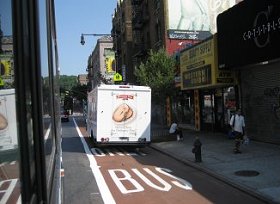During the 2010 Albany legislative season, transportation advocates put their weight behind six laws: four that dealt with enforcement and prosecution, one that established policy guidance on infrastructure spending, and one that would change the way that New York builds its roads. All four of the enforcement laws have been signed by the Governor. The infrastructure policy law was delivered to the governor on August 18 and is ready for his pen. Given Albany’s track record for passing less than 3% of laws introduced, this is a tremendous accomplishment. But the last, the “Complete Streets” law, is still stuck in the mire of Albany politics.
The four laws signed by Gov. Paterson were (original sponsors in parentheses):

- Bus Cameras (Assm. Bing/Sen. Dilan, passed in budget): Allows NYC to use camera enforcement to ticket drivers illegally blocking bus lanes — but only on five routes.
- Elle’s Law (Assm. Kellner/Sen. Dilan): Suspends the license of drivers who cause serious physical injury to someone while committing a traffic violation.
- Hayley and Diego’s Law (Assm. Kavanagh/Sen. Squadron): Creates a careless driving charge for those who drive “without due care” and seriously injure or kill a “vulnerable road user,” including pedestrians, cyclists, and roadway workers requiring that they complete traffic safety courses and community service.
- Merrill’s Law (Assm. Paulin/Sen. Stewart-Cousins): Creates a traffic infraction for drivers that don’t pass bicyclists at a “safe distance.”
Bringing bus lane cameras to New York City should provide compelling evidence of their effectiveness, potentially opening the door to greater use of cameras in the future. The three traffic safety laws will give police and prosecutors new tools to deter careless drivers and protect potential victims. Currently, careless drivers who injure or kill typically receive nothing more than a traffic ticket because prosecutors have few alternatives other than negligent homicide. Between 1994 and 2008, that charge was filed just 29 times in New York. The three safety laws were all named after victims of dangerous driving—Merrill Cassell, Elle Vandenberghe, Hayley Ng, and Diego Martinez—leading one advocate to claim that “if you want to get something passed in Albany, name it after someone who has died.” (Vandenberghe was seriously injured but fortunately was not killed when a car illegally backed into her as she was crossing the street.)
The legislative process did force several compromises. For example, Elle’s Law originally would have created a felony vehicular assault charge. The bus camera bill, as introduced, would have allowed cameras on 50 miles of bus lanes.
Further Action Needed on Smart Growth, Complete Streets

The Public Infrastructure Priority Act (A8011B/S5560B) wasn’t an easy sell either—versions of the law have been floating in Albany for at least the past 8 years. The law states that infrastructure spending must be “consistent with” smart growth principles, such as fix-it-first. As Streetsblog pointed out, whether this bill will be a success depends on how future state agency commissioners interpret the law. And that’s if Gov. Paterson signs the bill.
On the other hand, it’s pretty clear that the Complete Streets law would change the well-entrenched ways that roads have been designed for the past 50 years. In June, the bill’s sponsor, Assemblyman Gantt, attempted to gut the law by replacing the mandatory component with more amorphous wording; after substantial outcry, the law was re-amended. Of all the transportation bills in this legislative session, Complete Streets attracted the widest range of supporters—over 40 organizations have submitted letters in support, including health care, bicycling, aging, sustainable transportation, and environmental groups.
Yet the bill is stalled in the State Assembly. It will remain active until the end of the legislative season in December, and state legislators are set to return to Albany later this summer, giving them another opportunity to move the bill. If the legislature doesn’t act, perhaps advocates should consider renaming the law after the 336 pedestrians and cyclists that died on New York’s streets in 2008 (the most recent year state data was available).
Photos: Top – TSTC; Bottom – TSTC graphic using photo from AARP New York.

[…] MTR Wraps Up the Year in Albany […]
[…] by Steven Higashide Whether it’s how transit is funded, how streets are designed, or how traffic safety is enforced, elected officials play a key role in setting transportation policy, one which is larger than many […]
[…] law was a priority for Vision Long Island, Empire State Future, TSTC, and other transportation and planning groups, […]
[…] issues. Region 10 is not moving with the necessary urgency, and a state complete streets measure has been blocked in the State Assembly (Wantagh is represented by Assm. David McDonough). Change needs to happen […]
[…] approval of the State Legislature, which was withheld for years. Albany finally OKed the cameras this summer after a sustained advocacy effort, allowing the city to use them on five […]